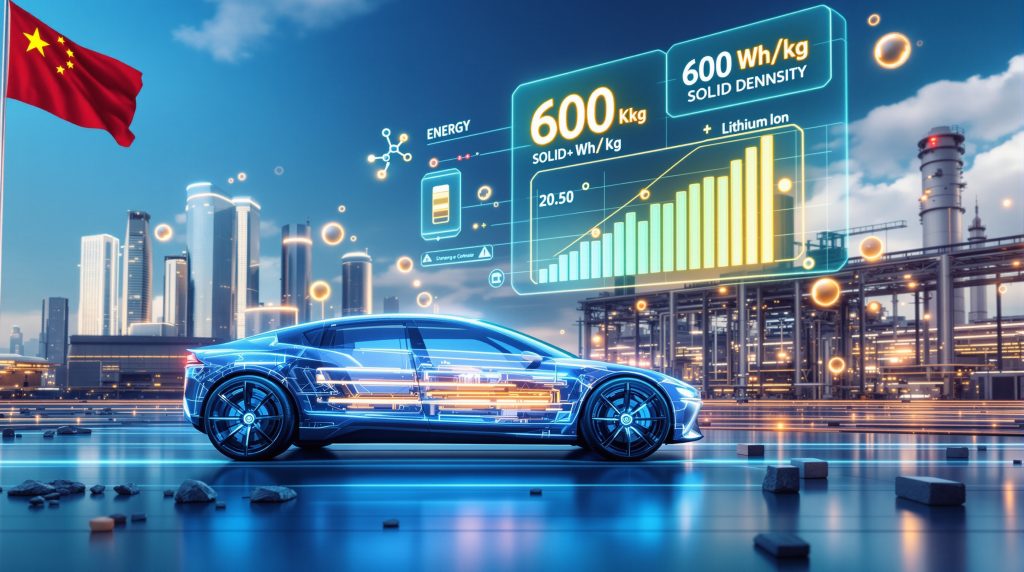China's ambitious pursuit of solid-state battery technology reflects a strategic initiative to establish global dominance in next-generation energy storage systems. This technological shift represents more than incremental improvement; it constitutes a fundamental reimagining of how energy storage can transform electric mobility and renewable energy integration, supporting the broader critical minerals energy transition.
Unlike conventional lithium-ion batteries that depend on liquid electrolytes, solid-state batteries utilise solid electrolyte materials, eliminating many safety concerns while dramatically improving performance metrics. Chinese manufacturers have positioned themselves at the forefront of this technological revolution, leveraging government support, private investment, and advanced research capabilities to accelerate development timelines.
Strategic Government Support and Market Positioning
The Chinese government has implemented export controls on high-performance lithium batteries and related materials, demonstrating the strategic importance of maintaining technological leadership in this critical sector. This policy framework affects both civilian electric vehicle applications and potential military uses, highlighting the dual-use nature of advanced battery technology.
Beijing's approach combines regulatory protection with substantial research funding, creating an environment where domestic companies can develop proprietary technologies while limiting international access to breakthrough innovations. This strategy mirrors China's approach in other critical technology sectors, establishing technological sovereignty as a national security priority.
Revolutionary Performance Capabilities for Electric Vehicles
Energy Density Breakthroughs Transform Vehicle Design
Chinese solid-state battery manufacturers have achieved unprecedented energy density levels that fundamentally alter electric vehicle capabilities. Current production samples demonstrate energy densities ranging from 400 to 600 Wh/kg, representing a two to three-fold improvement over conventional lithium-ion systems that typically deliver 150-250 Wh/kg.
Leading Performance Achievements:
• Chery's Rhino S module: 600 Wh/kg energy density with projected 1,200+ km range capability
• Sunwoda's polymer battery: 400 Wh/kg with demonstrated 1,200 charge cycle durability
• Advanced prototypes: Laboratory samples reaching 520+ Wh/kg energy density
• Beijing Easpring materials: Ultra-high nickel cathodes exceeding 400 Wh/kg performance
Range Capabilities Exceeding Conventional Vehicles
These energy density improvements translate into driving ranges that surpass most petrol-powered vehicles, potentially eliminating range anxiety as a barrier to electric vehicle adoption. Furthermore, advancements in direct lithium extraction technology are helping to secure the lithium supply needed for these breakthrough batteries.
| Battery Technology | Energy Density | Typical Range | Commercial Status |
|---|---|---|---|
| Current Li-ion | 150-250 Wh/kg | 300-500 km | Mass production |
| Chinese solid-state | 400-600 Wh/kg | 1,200-1,300 km | Pilot production |
| Advanced prototypes | 520+ Wh/kg | 1,800+ km | Laboratory phase |
| Target specifications | 700+ Wh/kg | 2,000+ km | Development phase |
Technical Challenges and Chinese Innovation Solutions
Interface Engineering Breakthroughs
Traditional solid-state batteries faced critical technical obstacles related to poor contact between solid sulphide electrolytes and lithium metal electrodes. This interface challenge created electrical resistance that significantly reduced battery efficiency and charging speed.
Chinese research teams have developed innovative solutions using specialised ionic compounds and interface engineering techniques. Moreover, the Chinese battery recycling breakthrough provides additional support for the sustainable development of these advanced technologies.
Technical Innovation Highlights:
• Iodine ion migration technology: Creates conductive pathways at critical electrode interfaces
• Specialised interface materials: Advanced compounds that function as conductive "glue" between components
• Enhanced ion transport mechanisms: Engineered pathways enabling smoother lithium-ion movement
• Multi-layered electrolyte systems: Composite structures optimising both conductivity and mechanical stability
Manufacturing Scale-Up and Cost Reduction
Chinese manufacturers are implementing comprehensive production strategies to overcome cost barriers and achieve commercial viability:
"Manufacturing process optimisation has already reduced solid-state battery production costs by approximately 40% compared to initial prototypes, though commercial units still cost three times more than conventional lithium-ion batteries."
Scaling Strategy Components:
• Automated production lines: Reducing labour costs and improving consistency
• Materials engineering: Developing lower-cost electrolyte formulations
• Supply chain integration: Vertical integration reducing intermediate costs
• Volume manufacturing: Economies of scale targeting 2027-2030 commercial launch
Leading Chinese Companies and Their Developments
Beijing Easpring Material Technology
Beijing Easpring has emerged as a key supplier of cathode materials for solid-state battery applications, delivering substantial quantities to multiple manufacturers. The company reported delivering over 20 tonnes per order of specialised cathode materials, including ultra-high nickel multi-element compounds and lithium-rich manganese-based formulations.
Production Scaling Achievements:
• Total cathode output: 73,133 tonnes in first half of 2025 (more than double previous year)
• Multi-element materials: Over 15,000 tonnes shipped in Q3 2025
• LFP production: More than 23,000 tonnes in Q3 2025
• International expansion: Building cathode production facility in Kotka, Finland
Chery Automotive's Solid-State Integration
Major Chinese automaker Chery unveiled its Rhino S all-solid-state battery module with breakthrough specifications targeting commercial vehicle integration by 2027. The module represents one of the most advanced solid-state systems approaching commercial readiness.
Technical Specifications:
• Energy density: 600 Wh/kg achieved in production modules
• Driving range: Supporting over 1,200 km on single charge
• Commercial timeline: Initial vehicle assembly verification planned for 2027
• Safety improvements: Solid electrolyte eliminating thermal runaway risks
Sunwoda Energy's Advanced Development
Battery manufacturer Sunwoda has developed the "Xin·Bixiao" polymer solid-state battery system, achieving competitive energy density with enhanced safety characteristics compared to liquid electrolyte systems.
Development Milestones:
• Commercial battery: 400 Wh/kg with 1,200 charge cycle capability
• Laboratory prototype: 520 Wh/kg lithium-metal super battery achieved
• Production timeline: Pilot production line launching end of 2025
• Scaling plans: Mass production targeting 2028-2030 timeframe
Critical Materials Driving Performance Advances
Ultra-High Nickel Cathode Materials
Solid-state batteries create new opportunities for mineral suppliers, particularly those facing oversupply conditions in traditional battery markets. The technology requires specialised materials that differ significantly from conventional lithium-ion formulations, influencing the broader battery metals landscape.
Essential Material Requirements:
• Ultra-high nickel precursors: 90%+ nickel content improving energy density
• Lithium metal anodes: Replacing graphite for 10x capacity improvement
• Solid electrolyte compounds: Sulphide, oxide, or polymer-based systems
• Advanced cathode materials: Supporting higher voltage operations (4.5V+)
Supply Chain Transformation
The transition to solid-state technology fundamentally alters raw material demand patterns, creating opportunities for suppliers of specific mineral grades while potentially reducing demand for others. Additionally, the establishment of a battery-grade lithium refinery in India demonstrates the global effort to secure lithium supply chains.
| Material | Current Application | Solid-State Opportunity | Demand Change |
|---|---|---|---|
| Nickel | NCM cathodes (33-80%) | Ultra-high nickel (90%+) | Higher grade demand |
| Lithium | Various compounds | Metal anode applications | New application segment |
| Manganese | LFP/NCM cathodes | Stability enhancement | Specialised compounds |
| Cobalt | High-performance cathodes | Reduced dependency potential | Possible decrease |
Commercial Timeline and Market Readiness
Phased Rollout Strategy
Industry projections indicate a carefully planned commercial introduction spanning multiple phases, with different applications targeting specific market segments based on cost tolerance and performance requirements.
Commercial Development Timeline:
2025-2026: Pilot production facilities and limited high-value applications
2027-2028: Initial vehicle integration testing and premium market introduction
2029-2030: Volume production scaling and mainstream market penetration
2031+: Mass adoption across multiple vehicle segments and energy storage applications
Cost Reduction Challenges and Solutions
Current solid-state batteries cost approximately three times more than conventional lithium-ion technology, presenting the primary barrier to widespread adoption. Chinese manufacturers have implemented comprehensive cost reduction strategies:
Cost Optimisation Approaches:
• Manufacturing process improvements: Automated production reducing labour costs by 60%
• Materials engineering advances: Lower-cost electrolyte formulations under development
• Production volume scaling: Target cost reductions of 70% through economies of scale
• Supply chain integration: Vertical integration eliminating intermediate markups
"Industry analysis suggests that initial solid-state battery costs will limit adoption to premium vehicle segments, with mainstream affordability not expected until after 2030."
Global Competitive Dynamics and Strategic Implications
Export Controls and Technology Transfer Limitations
China pushes solid-state batteries through strategic export controls on high-performance lithium batteries and critical materials, demonstrating the technology's perceived strategic value. These controls affect both civilian electric vehicle markets and potential military applications, establishing solid-state batteries as dual-use technology requiring careful oversight.
The export control framework includes:
• Technology transfer restrictions: Limiting foreign access to manufacturing processes
• Material export controls: Regulating critical cathode and electrolyte materials
• Equipment limitations: Restricting specialised manufacturing equipment exports
• Intellectual property protection: Enhanced patent protection for breakthrough innovations
International Response and Competition
Global competitors are accelerating their solid-state battery programmes in response to Chinese technological advances, creating an international race for next-generation energy storage dominance:
Regional Competition Analysis:
• Japanese manufacturers: Toyota and Panasonic advancing solid-state research with 2027 targets
• South Korean companies: LG Energy Solution and Samsung SDI developing alternative approaches
• European initiatives: EU government-backed research programmes with €2 billion funding
• United States investments: Federal funding exceeding $3 billion for domestic battery technology
Broader Market Impact Beyond Transportation
Electric Vehicle Industry Transformation
Successful solid-state battery commercialisation could fundamentally alter electric vehicle market dynamics, addressing current limitations while enabling new vehicle design possibilities:
Transformative Impacts:
• Range anxiety elimination: 1,200+ km ranges exceeding most petrol vehicles
• Safety profile improvements: Solid electrolytes reducing fire risks by 90%+
• Charging speed potential: Fast charging capabilities targeting 10-minute sessions
• Vehicle design flexibility: Higher energy density enabling lighter, more efficient designs
Energy Storage Applications Beyond Automotive
The technology's superior energy density and safety characteristics create opportunities across multiple sectors requiring reliable energy storage solutions:
Application Sectors:
• Grid-scale energy storage: Higher density enabling smaller installation footprints
• Consumer electronics: Longer-lasting, safer portable devices with rapid charging
• Aerospace applications: Weight-critical applications benefiting from density improvements
• Industrial equipment: Enhanced performance for specialised machinery and backup systems
Technical Specifications and Performance Metrics
Laboratory vs Commercial Performance
Chinese manufacturers have demonstrated significant progress in translating laboratory achievements into commercial prototypes, though gaps remain between theoretical potential and production reality. According to Inside EVs, Chinese companies are achieving remarkable progress in developing solid-state batteries capable of delivering 800-mile (1,287 km) range.
Performance Comparison:
• Laboratory samples: 520-600 Wh/kg achieved under controlled conditions
• Pilot production: 400-500 Wh/kg in manufacturing environment
• Commercial targets: 350-450 Wh/kg for initial market introduction
• Long-term goals: 700+ Wh/kg through advanced materials and processing
Safety and Durability Characteristics
Solid-state batteries offer significantly improved safety profiles compared to liquid electrolyte systems, addressing key concerns about thermal runaway, fire risk, and mechanical failure:
Safety Advantages:
• Thermal stability: Operating range from -20°C to +80°C without degradation
• Fire risk reduction: Non-flammable solid electrolytes eliminating explosion hazards
• Mechanical robustness: Solid construction resisting physical damage and puncture
• Chemical stability: Reduced electrolyte decomposition extending operational life
Investment Implications and Market Opportunities
How Will Raw Material Demand Shift?
The transition to solid-state technology creates new investment opportunities while potentially disrupting existing supply chains. Materials with current oversupply conditions may find new applications, while specialised compounds command premium pricing.
Investment Considerations:
• High-grade nickel: Ultra-pure nickel requirements creating premium market segments
• Lithium metal processing: New refining capabilities needed for anode applications
• Specialty chemicals: Solid electrolyte materials requiring advanced chemical processing
• Manufacturing equipment: Specialised production machinery representing significant capital investment
Manufacturing Infrastructure Requirements
Successful solid-state battery production requires substantial infrastructure investments, creating opportunities for equipment suppliers and construction companies:
Infrastructure Needs:
• Clean room facilities: Advanced manufacturing environments preventing contamination
• Specialised equipment: Custom machinery for solid electrolyte processing
• Quality control systems: Advanced testing equipment ensuring consistent performance
• Skilled workforce: Technical personnel trained in solid-state manufacturing processes
Regional Market Development and Export Potential
Domestic Market Foundation
China's large domestic electric vehicle market provides an ideal testing ground for solid-state battery technology, allowing manufacturers to refine products before international expansion. The domestic market's size enables economies of scale that reduce production costs faster than would be possible in smaller markets.
Domestic Advantages:
• Market size: 200+ million potential EV customers creating substantial demand
• Government support: Subsidies and incentives accelerating adoption
• Infrastructure development: Charging networks supporting long-range vehicles
• Consumer acceptance: Growing familiarity with advanced battery technology
International Expansion Strategy
Chinese solid-state battery manufacturers are pursuing selective international expansion, focusing on markets with favourable regulatory environments and strong demand for premium electric vehicles. Furthermore, experts at Argus Media note that whilst China pushes solid-state batteries aggressively, questions remain about commercial viability and timeline.
Target Markets:
• European Union: Premium vehicle segments willing to pay technology premiums
• Southeast Asia: Emerging markets with growing electric vehicle adoption
• Latin America: Regional expansion opportunities with supportive policies
• Selected partnerships: Technology licensing agreements with international manufacturers
Conclusion: China's Technological Leadership Strategy
China's comprehensive approach to solid-state battery development represents a calculated strategy to establish technological leadership in next-generation energy storage. This initiative combines government policy support, substantial private investment, advanced research capabilities, and strategic export controls to create competitive advantages that extend beyond simple technological superiority.
The successful commercialisation of solid-state batteries could reshape global electric vehicle markets, energy storage applications, and raw material supply chains. Chinese manufacturers have demonstrated significant technical progress, achieving energy densities that exceed conventional batteries by substantial margins while addressing key safety concerns.
However, significant challenges remain. Cost reduction represents the primary barrier to widespread adoption, with current solid-state batteries costing approximately three times more than conventional alternatives. Manufacturing scalability, supply chain development, and international market acceptance will determine whether China pushes solid-state batteries to achieve their transformative potential.
The timeline for mass adoption remains uncertain, with most industry projections targeting the late 2020s for meaningful commercial deployment. Technical breakthroughs in energy density, interface engineering, and manufacturing processes suggest that solid-state batteries may transition from laboratory curiosities to commercial reality sooner than previously anticipated.
As this technology matures, its impact will extend far beyond transportation, potentially transforming how societies store and utilise energy across multiple sectors. The development of solid-state batteries also establishes new patterns of international technological competition, supply chain dependencies, and strategic resource requirements that will influence global energy markets for decades to come.
"The successful development of solid-state battery technology represents more than incremental improvement in energy storage; it constitutes a fundamental shift toward safer, more efficient, and more capable energy systems that could accelerate the global transition to sustainable transportation and renewable energy integration."
Ready to Capitalise on the Battery Technology Revolution?
Discovery Alert's proprietary Discovery IQ model delivers real-time alerts on significant battery metals and critical minerals discoveries, instantly empowering subscribers to identify actionable opportunities ahead of the broader market as solid-state battery technology reshapes material demand. Begin your 30-day free trial today and secure your market-leading advantage in this transformative sector.




